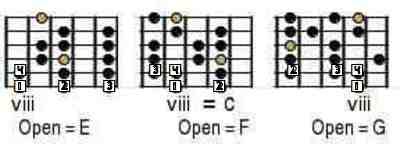|
| WORKING WITH TETRACHORDSI find myself getting easily bored with searching for recognizable notes. I need to know more about what I am doing than just constantly shooting in the dark trying to hit some mark. It occurs to me that there are actually 40,320 ways to arrange 8 notes, without repeating a note. That's too many to memorize. So I took another look at tetrachords. There are only 24 ways to arrange a tetrachord. Here is an arrangement of 24 ways to play C-D-E-F.
| CDEF | CEFD | CFDE | CFED | CEDF | CDFE | | DEFC | DFCE | DCEF | DCFE | DFEC | DECF | | EFCD | ECDF | EDFC | EDCF | ECFD | EFDC | | FCDE | FDEC | FECD | FEDC | FDCE | FCED |
I have highlighted the first four notes on the finger-picking patterns below.

You can take one of these 4-note patterns and play it over and over again in 24 ways. Whats more is that you can move up the strings, not just from tuners to bridge but also from the 6th string to the 5th string, etc. and repeat the pattern in another key. The pattern only changes when you go from the 3rd string to the 2nd string. In these patterns a P1 is aligned with a P4 except for on the 2nd string, where the P4 is up one fret, but from 2 to 1 they are aligned again. In the finger-picking patterns here, ignore them when practicing tetrachords. Just take the 4 note pattern and see how it will fit in with a change in key. CDEF end on F (P4) but a tetrachord on the 5th string beginning in the key of F continues with the first four notes of that key, FGABb, a sequence of steps equal to 1-1-1/2 from F. The next tetrachord up to the 3rd string would be in the key of Bb, BbCDEb, and so on. Somewhere along the line, if you actually learned all the tetrachords, you would have learned all the scales in all the keys. Put two tetrachords together and I guess you will have learned 40,320 notes eventually. |
